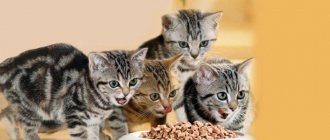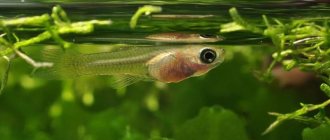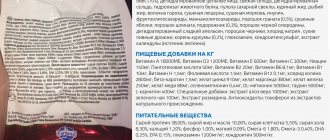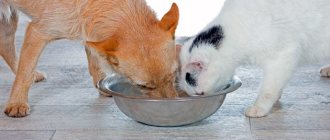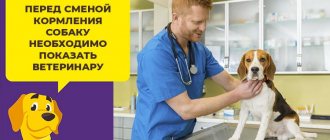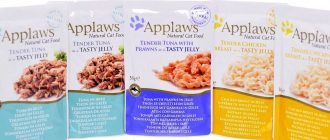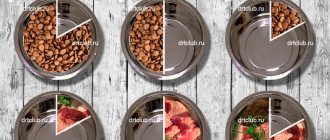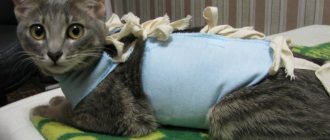Is it possible to feed a kitten adult food?
Let us immediately decide that without good reason, long-term feeding of a baby with such foods is strictly contraindicated! And there are several quite objective reasons for this.
What is the difference between food for kittens and adult cats?
What is the difference between food produced specifically for adult pets and kittens:
- The composition of food for kittens and adult cats is completely different! They contain different amounts of nutrients, micro- and macroelements, vitamins. In adult cats, the need for them is lower, but in kittens it is higher, and much more so.
- The granules of “adult” food are more “outstanding” in size, they are simply tougher. And this is a very important nuance, since the teeth of young kittens have a very thin layer of enamel, which quickly chips and falls off. As a result, the baby may be left without teeth at all.
And it’s worth separately warning lovers of “savings”: even adult cats do not need to be fed with cheap dry food sold by weight. Apart from grains and a couple of percent of old offal, they contain nothing. A kitten on such a diet will take a long time to grow and develop, and it is possible that it will develop chronic diseases of the digestive system.
Thus: adult food can be given to kittens, but only in cases where there is no other choice. And even in such situations, prolonged feeding of such food should not be allowed. All this can affect the health of a growing animal in the future.
By the way, there is also no need to feed an adult cat with baby food: since the diet for kittens contains noticeably more nutrients, the cat can quickly become fat.
What is the difference between food for an adult cat and food for a kitten?
To organize proper nutrition for a kitten, it is important to understand the difference between the foods of each age category. This principle does not particularly apply to those pets who receive a natural menu. Of course, every sensible owner understands that a kitten’s diet should be richer than for adult animals. While the kitten is growing, it needs much more vitamins and microelements.
Essential nutrients are important for a growing cat's body:
- proteins take an active part in the formation of the skeleton and muscle tissue;
- fats actively affect the development of the brain and coat, facilitate the absorption of vitamins, and also create the necessary layers to support internal organs;
- carbohydrates organize motor processes and ensure the activity of the little naughty boy.
Kittens are active most of the day, unlike adult cats, who sleep up to 80% of the time, so the food should provide the kids with energy
The high calorie content of baby food ensures maximum saturation of the baby, which is consumed at cosmic speed during games. When making food for kittens, the size of the granules is also taken into account. They are ideal for kitten's baby teeth. Their relative softness eases the load on the yet unformed jaw apparatus, and during the period of changing teeth the kitten does not experience discomfort.
The food for kittens contains an ideal percentage of products: meat, plant products, fish.
Kitten food takes into account the needs of the growing body
As for wet food, they do not differ much from dry food in terms of the content of nutrients. The only point worth paying attention to is the time of satiety. Wet food is digested much faster than dry food, and as a result, hunger comes faster. Therefore, you need to follow the portion size and number of feedings recommended by the manufacturer.
Table: comparison of dry food for adult cats and kittens of the Royal Canin brand
| Royal Canin formulation for adult cats that are often outdoors | Royal Canin composition for kittens |
Compound:
Composition of vitamins and microelements:
The nutritional value:
| Compound:
Nutritional Supplements:
The nutritional value:
|
When is it possible to switch to adult types of feed?
All veterinarians, cat food manufacturers and experienced breeders believe that it is possible to switch your pet to adult food only when he is one year old. This is especially true for representatives of large breeds (Maine Coons, for example).
This is due to the fact that in childhood these animals exhibit simply phenomenal growth rates. Accordingly, even “baby food” should be selected for them in a special way, and early transfer to adult types of food is strictly contraindicated.
Only in some cases, based on the results of consultation with a veterinarian and all the necessary tests, do they sometimes begin to switch kittens to an adult type of diet closer to eight months of age. But still, experienced breeders agree that there is no need to rush. A year is the optimal period for “nutritional maturation” .
Proper transition of an animal to a new food
The main rule is simple - the transfer should be carried out smoothly and gradually, without sudden changes in the characteristics of the diet. Adult food is introduced into the diet gradually, in limited quantities. To comply with this rule, adult food must be added to baby food gradually over a period of about a month.
- In the first week, you need to give your pet 30% new food and 70% old food. We would not recommend mixing wet food, and therefore they need to be alternated throughout the day (accordingly, 30% of the total daily diet should be new food).
- During the first month, baby food is 100% replaced by adults.
- In the case where the owner prefers to adhere to a natural type of diet, he needs to consult with a veterinary nutritionist in advance. A specialist will help you create a new diet and give recommendations on when and how to carry out the transfer.
Feed quality comes first
Whatever food you choose, the first thing you should be interested in is quality. Products for animals are traditionally divided into classes: economy, super-premium and premium, holistic and medicinal . The holistic class is the highest quality, but premium classes are suitable for feeding healthy animals. Medicinal foods are intended only for the prevention and treatment of existing health problems. Healthy animals should not be fed medicated feed, as this will have the opposite effect.
Many food manufacturers divide their food into several more lines:
- For kittens.
- For pregnant and lactating cats.
- Junior – for teenagers.
- For adult cats.
- For older cats.
This division was introduced for a reason. Feeds vary in composition and, in theory, should best meet the needs of an animal at a certain age or condition. For example, food for pregnant and lactating cats is fattier than all other types, but in this condition this is only beneficial for the cat.
Packed rations or canned food?
There is still fierce debate on this topic among animal lovers, with no end in sight. However, there is no clear answer to this question.
Dry food
Oddly enough, dry food is not the worst option. In any case, it is definitely no worse and much safer than food waste, which is full of spices and salt, which do not have the best effect on the baby’s health. It is only important to understand that the animal’s daily diet should consist of at least 70% wet food. This requirement applies to kittens under six months of age. From six months of age to one year, the ratio is adjusted to 50/50. If you buy good food, then there is nothing wrong with using it.
Wet food
Again, contrary to the common misconception that wet food is the best option for feeding kittens, in practice everything is not so clear-cut. It is better only if the product belongs to the “Premium” or “Super-premium” class. Cheap wet food is frankly dangerous for the health of kittens, since there is simply nothing useful in it. At best, it is a mixture of ground sinews and hooves with gelatin and cereals.
You can feed your kitten any food, but only high-quality food.
It would seem a banal rule, but owners often forget about it. Simply put, the kitten will be much healthier if you give it a good dry diet, rather than cheap canned food that does not and never has had meat.
Oh is also not a panacea. If a kitten is underfed or, on the contrary, overfed, nothing worthwhile will grow out of it. In order for the pet to be truly healthy and vigorous, in any case it would not hurt the owner to consult a veterinarian.
Which food to choose
Today, pet stores offer a large selection of food for kittens - from budget to super premium. How are they different?
Economy
Produced from cheap raw materials. The composition, as a rule, includes meat by-products, soy, as well as preservatives, dyes and various flavor enhancers. That is why it is extremely undesirable to constantly feed your pets such food, despite the fact that they gobble it up with great pleasure. The vitamin content is minimal, so you will have to additionally give various vitamin and mineral complexes.
Cheap food contains addictive substances. As a result, the animal, like a dependent person, refuses to consume a quality product and experiences some kind of withdrawal.
Premium
The cost of such cat food is slightly higher, which is due to the inclusion of natural meat. But despite this, the components include by-products, vegetable protein, and preservatives with dyes. A certain proportion of useful substances is present, but periodically it is still worth adding vitamins and minerals to your pet’s diet.
Superpremium
Only meat is used for production. The product is perfectly balanced, it contains everything that a growing body needs. There are no flavor enhancers or flavorings in it, the only preservative is vitamin E, which brings nothing but benefits. Due to high demand and high cost, you can often come across a fake, so buy only from trusted places.
Optimal diet for kittens
The young predator can be fed both ready-made industrial diets and natural food specially selected for the cat junior menu.
Natural nutrition
With a certain investment of money and time, owners will be able to create a complete daily diet for their pets. The most suitable natural foods for growing kittens are:
- beef scraper, and subsequently raw beef, cut into small pieces;
- baby meat puree, and later boiled chicken or turkey, chopped into small pieces, as well as boiled offal (liver, kidneys, heart, udder, lungs);
- well-cooked milk porridges (oatmeal and rice), and subsequently porridge with water;
- low-fat cottage cheese;
- cream with a fat content of 9-10%, and subsequently lactic acid products (unsweetened yogurt, curdled milk, kefir, fermented baked milk);
- boiled low-fat sea fish;
- chicken egg yolk.
Kittens kept on a natural diet are recommended to be fed a daily vitamin and mineral supplement in the form of powder or tablets.
Industrial rations
High-quality ready-made food contains the optimal amount of nutrients, as well as vitamins and minerals, in accordance with the age and breed characteristics of the pet. The serving size of the product is indicated on the bag of dry food or on the can of canned food. As the first complementary food for one-month-old babies, you should choose wet food (packaged portioned pouches or canned food), or soak dry food granules to a pulp.
The best brands. Among the huge range of foods for babies, it is recommended to choose expensive foods: holistic or super-premium:
- Royal Canin Kitten;
- Orijen Cat & Kitten;
- Acana (kitten range);
- Pronature Original Kitten;
- Bosch Sanabelle Kitten.
Peculiarities of feeding with commercial diets by age. For kittens over 3 months old, it is possible to eat exclusively dry food or a mixed diet, for example: Royal Canin Kitten dry food and Kitten Instinctive pouches (wet pieces in sauce).
It is recommended to feed your cat a “baby” diet until it reaches one year of age.
The exception is large, late-maturing breeds, which actively grow until 15-18 months and complete their formation by 2.5-3 years. For such “mini-tigers” there are special dry diets with an enhanced nutritional formula, for example, Royal Canin Kitten Maine Coon.
Taboo on cheap food. Cheap economy-class food is made from low-quality raw materials (for example, feather meal) and contains many chemical additives, flavorings, and taste enhancers. Such food can be used for forced feeding of adult animals, but they are not suitable for those who care about the health of a still developing and growing pet.
Also watch the video: Is it possible to feed a kitten food for adult cats:
What to pay attention to
Today there is a huge variety of food available on the market. Yes, it is not difficult to purchase specialized food for a particular animal, but many animal owners stubbornly continue to experiment. Some people start feeding their cats from the table, others even give them dog food. The owner of the animal can constantly change the manufacturer, etc., but you need to understand that kitten food is contraindicated for adult cats, since it contains more than 30% carbohydrates, proteins, additives and vitamin complexes aimed at the growth of the animal. If your pet eats this way, it can lead to stomach problems and obesity.
Elderly cats need vitamins that stimulate the functioning of the kidneys and liver, since diseases of these organs often cause the animal’s premature death. There are no such components in food for kittens, since young pets rarely have such health problems.
How and when to switch a kitten to “adult” food?
The first thing to consider is that an older kitten should be accustomed to dry food for mature cats gradually. And under no circumstances should we translate abruptly: yesterday the pet ate baby food, and today we’ll give it adult food! This is absolutely impossible to do. First, the food should be soaked in water or milk and given little by little, mixed into the kitten’s usual food. Thus, every day the portions need to be increased and the amount of liquid reduced. And the main thing that is important to remember: you can strictly give your small pet food for adult cats no earlier than three months of age! Otherwise, the baby’s stomach will not be able to cope with such a load. After switching to a new diet, it is not recommended to return to kitten food - it is not only unnecessary, but also quite harmful for adult animals. Buy based on the information on the packaging.
Features of the diet for kittens
In order to easily digest and absorb food, kittens must have a healthy digestive system, which is so easy to “break” at a young age. In addition, the physiological needs for feed ingredients for young and adult animals are significantly different. The following information will help you create the right diet for small pets:
- The energy requirement of a kitten at the age of 1-2 months exceeds the energy expenditure of an adult animal by 3-4 times (in terms of 1 kg of body weight), which is explained by enhanced metabolic processes. That is why the diet of babies should be high-calorie and easily digestible.
- Cats are carnivores, which means their diet should be based on high-quality protein found in animal products. Feed protein is necessary for building the body’s own tissues, so protein poverty in the diet leads to growth retardation, disruptions in the immune system, and impaired liver and kidney function. The optimal protein requirement for babies is at least 10 g per 1 kg of body weight, compared to the norm of 6.3 g per 1 kg of body weight for adult cats. Thus, growing kittens should receive 1.5 times more protein in their food than mature animals.
- The most important nutritious protein product for small kittens is milk. In their digestive tract, under the influence of the lactase enzyme, lactose (milk sugar) is digested, while in adult animals this enzyme is absent and drinking milk can result in intestinal upset.
- Vitamins are biologically active substances that trigger the most important life processes, which is why vitamin deficiencies have such a detrimental effect on the growth and development of the younger cat generation. The needs of kittens for vitamins of various groups are on average 50% higher than those of adult cats (calculated per 1 kg of body weight).
- Minerals are necessary, first of all, for the construction of a growing skeleton and the formation of teeth. In addition, macro- and microelements are necessary for the regulation of metabolism and the normal functioning of all organs and systems. Young cats, in comparison with adults, need an increased supply of minerals from food, and this difference is twofold for calcium, magnesium and phosphorus.
- By the age of 2 months, a kitten’s baby teeth are formed, so all food in early childhood should be served in liquid and warm form. In addition, crushed food is much easier to digest for a delicate stomach and is absorbed by the intestines with unsettled microflora.
- The transition from puree to solid food should be step-by-step with a gradual reduction in the amount of water. By learning to use its jaws and chew, the kitten will be able to chew on pieces of food, while the active enzymes of a stronger digestive system will digest rougher food.
A small kitten may well taste food from its mother’s bowl and this will not cause him much harm.
However, the long-term nutritional program for cubs must be special.
